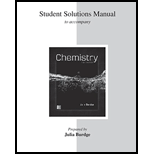
Concept explainers
Interpretation:
The heat of combustion of the given reactions is to be calculated with reference of standard enthalpies of formation listed in appendix
Concept introduction:
Answer to Problem 68QP
Solution:
(a)
(b)
Explanation of Solution
a)
The combustion of the given reaction is as follows:
From appendix 2,
The enthalpy of the formation oxygen gas is zero because it is in its most stable form.
Calculate the standard enthalpy of the reaction:
Substitute
Hence, the value of the standard enthalpy of the reaction is
b)
The combustion of the given reaction is as follows:
From appendix 2,
The enthalpy of the formation of oxygen gas is zero because it is in its most stable form.
Calculate the standard enthalpy of the given reaction as follows:
Substitute
Hence, the value of the standard enthalpy of the reaction is
Want to see more full solutions like this?
Chapter 5 Solutions
Student Solutions Manual for Chemistry
- Calculate the standard enthalpy of combustion for benzene, C6H6. C6H6() + 15/2 O2(g) 6 CO2(g) + 3 H2O() rH = ? The enthalpy of formation of benzene is known [rH[C6H6()] = +49.0 kJ/mol], and other values needed can be found in Appendix L.arrow_forwardSodium carbonate, Na2CO3, is used to manufacture glass. It is obtained from sodium hydrogen carbonate, NaHCO3, by heating. 2NaHCO3(s)Na2CO3(s)+H2O(g)+CO2(g) Calculate the standard enthalpy of reaction, using enthalpies of formation (Table 6.2).arrow_forwardWhite phosphorus, P4, ignites in air to produce P4O10. When 3.56 g P4 is burned, 85.8 kJ of thermal energy is evolved at constant pressure. Calculate the combustion enthalpy of P4.arrow_forward
- Gasohol, a mixture of gasoline and ethanol, C2H5OH, is used as automobile fuel. The alcohol releases energy in a combustion reaction with O2. C2H5OH(l)+3O2(g)2CO2(g)+3H2O(l) If 0.115 g ethanol evolves 3.62 kJ when burned at constant pressure, calculate the combustion enthalpy for ethanol.arrow_forwardFind the enthalpies of the combustion reactions for methane through n-octane. Plot them versus the number of carbon atoms in the molecule, and determine an equation that gives H for the combustion of a given hydrocarbon. Then use the equation to predict the enthalpy of combustion for n-C12H26 and compare it to experimental values.arrow_forwardNitrogen gas (2.75 L) is confined in a cylinder under constant atmospheric pressure (1.01 105 pascals). The volume of gas decreases to 2.10 L when 485 J of energy is transferred as heat to the surroundings. What is the change in internal energy of the gas?arrow_forward
- Is the following reaction the appropriate one to use in determining the enthalpy of formation of methane, CH4(g)? Why or why not? C(g)+4H(g)CH4(g)arrow_forwardThe enthalpy change for the following reaction is 393.5 kJ. C(s,graphite)+O2(g)CO2(g) (a) Is energy released from or absorbed by the system in this reaction? (b) What quantities of reactants and products are assumed? (c) Predict the enthalpy change observed when 3.00 g carbon burns in an excess of oxygen.arrow_forwardWhen 2.50 g of methane burns in oxygen, 125 kJ of heat is produced. What is the enthalpy of combustion per mole of methane under these conditions?arrow_forward
- A 10.00-g sample of acetic acid, HC2H3O2, was burned in a bomb calorimeter in an excess of oxygen. HC2H3O2(l)+2O2(g)2CO2(g)+2H2O(l) The temperature of the calorimeter rose from 25.00C to 35.84C. If the heat capacity of the calorimeter and its contents is 13.43 kJ/C, what is the enthalpy change for the reaction?arrow_forwardThe Romans used calcium oxide, CaO, to produce a strong mortar to build stone structures. Calcium oxide was mixed with water to give Ca(OH)2, which reacted slowly with CO2 in the air to give CaCO3. Ca(OH)2(s) + CO2(g) CaCO3(s) + H2O(g) (a) Calculate the standard enthalpy change for this reaction. (b) How much energy is evolved or absorbed as heat if 1.00 kg of Ca(OH)2 reacts with a stoichiometric amount of CO2?arrow_forwardThe head of a strike anywhere match contains tetraphosphorus trisulfide, P4S3. In an experiment, a student burned this compound in an excess of oxygen and found that it evolved 3651 kJ of heat per mole of P4S3 at a constant pressure of 1 atm. She wrote the following thermochemical equation: P4S3(s)+8O2(g)P4O10(s)+3SO2(g);H=3651kJ Calculate the standard enthalpy of formation of P4S3, using this students result and the following standard enthalpies of formation: P4O10(s), 3009.9 kJ/mol; SO2(g), 296.8 kJ/mol. How does this value compare with the value given in Appendix C?arrow_forward
 Chemistry by OpenStax (2015-05-04)ChemistryISBN:9781938168390Author:Klaus Theopold, Richard H Langley, Paul Flowers, William R. Robinson, Mark BlaserPublisher:OpenStax
Chemistry by OpenStax (2015-05-04)ChemistryISBN:9781938168390Author:Klaus Theopold, Richard H Langley, Paul Flowers, William R. Robinson, Mark BlaserPublisher:OpenStax General Chemistry - Standalone book (MindTap Cour...ChemistryISBN:9781305580343Author:Steven D. Gammon, Ebbing, Darrell Ebbing, Steven D., Darrell; Gammon, Darrell Ebbing; Steven D. Gammon, Darrell D.; Gammon, Ebbing; Steven D. Gammon; DarrellPublisher:Cengage Learning
General Chemistry - Standalone book (MindTap Cour...ChemistryISBN:9781305580343Author:Steven D. Gammon, Ebbing, Darrell Ebbing, Steven D., Darrell; Gammon, Darrell Ebbing; Steven D. Gammon, Darrell D.; Gammon, Ebbing; Steven D. Gammon; DarrellPublisher:Cengage Learning Chemistry & Chemical ReactivityChemistryISBN:9781337399074Author:John C. Kotz, Paul M. Treichel, John Townsend, David TreichelPublisher:Cengage Learning
Chemistry & Chemical ReactivityChemistryISBN:9781337399074Author:John C. Kotz, Paul M. Treichel, John Townsend, David TreichelPublisher:Cengage Learning Physical ChemistryChemistryISBN:9781133958437Author:Ball, David W. (david Warren), BAER, TomasPublisher:Wadsworth Cengage Learning,
Physical ChemistryChemistryISBN:9781133958437Author:Ball, David W. (david Warren), BAER, TomasPublisher:Wadsworth Cengage Learning, Chemistry: The Molecular ScienceChemistryISBN:9781285199047Author:John W. Moore, Conrad L. StanitskiPublisher:Cengage Learning
Chemistry: The Molecular ScienceChemistryISBN:9781285199047Author:John W. Moore, Conrad L. StanitskiPublisher:Cengage Learning Chemistry: Principles and PracticeChemistryISBN:9780534420123Author:Daniel L. Reger, Scott R. Goode, David W. Ball, Edward MercerPublisher:Cengage Learning
Chemistry: Principles and PracticeChemistryISBN:9780534420123Author:Daniel L. Reger, Scott R. Goode, David W. Ball, Edward MercerPublisher:Cengage Learning





